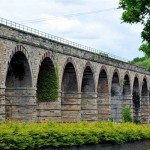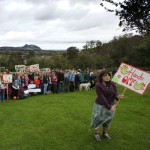For those families living nearby in Garrioch Road, Kelbourne Street, Sanda Street and Clouston Street, the name is synonymous with the green space that has greeted them each morning as they open their curtains for generations. Bought from private owners by Glasgow City Council in 1939, the land has remained undeveloped throughout its existence. It […]
Support independent, non-corporate media.
Donate here!
For those families living nearby in Garrioch Road, Kelbourne Street, Sanda Street and Clouston Street, the name is synonymous with the green space that has greeted them each morning as they open their curtains for generations. Bought from private owners by Glasgow City Council in 1939, the land has remained undeveloped throughout its existence. It has seen some changes of use over the years: during World War 2 it was used to float barrage balloons to protect the BBC building on Queen Margaret Drive. After the war, the land was used as a sports ground by the local school until its closure, when it fell into disuse and has not since been maintained by the City Council.
Despite neglect by the local authority, the green space has been in constant use by local residents as a leisure facility and a right of way across the land between Kelbourne Street and Clouston Street. At present the area is well grassed, with a significant number of healthy, mature trees, with natural regeneration increasing these numbers year on year. Local residents have actively cared for the land for at least the last five years: litter picking, planting grass and trees to develop the land into a pleasant, useful local amenity.
In 2008, Glasgow City Council put forward proposals for development of the entire space for residential purposes. They fielded four options, which were almost identical, other than the architects used to produce the plans. Locals were given no alternative option for consideration by the council other than development of the entire green space for housing.
Local opposition to the scheme was rejected by the council and in the same year – 2008 – the North Kelvin Meadow Campaign was formed to save the space for residents.
The Current Position
It would appear that the concern of Glasgow City Council is to sell the land for development as a revenue raising exercise. They have no doubt studied in depth business projections and conducted rigorous financial forecasts in relation to their proposals, and can justify the loss of the land in terms of revenue gained, at least part of which can be invested in other areas of the city. While it’s possible to understand the economics of the situation (no different to that of many local authorities throughout Scotland and the rest of the UK), they have seemingly neglected to study their own legislation and guidelines in respect of any inner city development.
Looking at the range of documents available online it is simply not credible that they could have overlooked the many factors which contribute to the argument for retaining North Kelvin Meadow as a green space. However, they may be ignoring not only valid local concerns as to the loss of use of the land as an amenity, its aesthetic value and the consequent intrusion into the community of such high density development as is envisaged, but also legislation and guidelines set out under: the Town and Country Planning (Scotland) Act of 1972; GreenLINK; the Chartered Society of Designers; and the Scottish Government’s Planning Advice Note 65: Planning and Open Space (PAN65). There seems to be considerable conflict between the City Council’s proposals and such existing framework.
In 1972, under the Town and Country Planning (Scotland) Act, the West End of Glasgow was designated as a Conservation Area. The later designation of the West End as a Conservation Area (Amended Glasgow West Conservation Area, 2011) definitively includes North Kelvin Meadow within its boundaries.
Why the meadow should be preserved as a green space
The objectives of a Conservation Area are:
– to define what is important about its character and appearance
– to enable the active management of the Conservation Area
– to identify the area’s special features and changing needs
– to enhance, preserve and protect the area from inappropriate and unsympathetic developments.
As a Conservation Area, it is not merely the buildings, but also the spaces between them that are of architectural or historical interest. Planning control should be directed at maintaining the integrity of the whole area. While Conservation Area status does not preclude development, care must be taken to ensure that such development will not tarnish the character or appearance of the area. Further, designation of an area as a onservation Area should be regarded as a positive step towards its protection and enhancement.
In addition to the preservation and enhancement of a Conservation Area, the character or setting of such area also depends upon individual or distinctive groups of trees. Designation of an area as a Conservation Area gives temporary protection to all trees falling within that area; such protection can be made permanent by Tree Preservation Orders. Guidance for the conservation of the environment can be found in National Planning Policy Guidelines on Planning and the Historic Environment (NPPG18).
The proposal to develop the entire site would also seem to come into conflict with Glasgow City Plan 2, adopted in 2009. Under this, the Council is to “support proposals which enhance residential amenity, improve access to, from and within areas and preserve or enhance the integrity of the townscape, landscape and green network provision.” As part of their Housing Policy, Glasgow City Council must: “consider residential layout to create high quality and attractive residential environments that have *minimal environmental impact*”; “Residential Greenspace standards should be considered when making any development proposals”.
What of the residential greenspace standards as laid out in the Scottish Government’s Planning Advice Note 65? PAN65 states that open spaces are important for quality of life, providing the setting for a broad spectrum of social interactions and activities that support personal and community well-being. Green spaces provide opportunity for people to interact with the natural environment and help protect wildlife habitats. They also play a significant role in the character and identity of the area.
The Planning Note gives advice on the role of the planning system in relation to the protection and enhancement of existing open spaces and sets out the way in which local authorities can provide, manage and maintain open spaces in accordance with good practice guidelines.
In addition, the Planning Note explains three key factors that should be taken into consideration when managing green spaces. The first factor is that, socially, well-managed and maintained spaces allow opportunity for interaction to all sections of the local community, developing and enhancing a sense of pride and of a place in the community; as well as allowing people to be actively involved in caring for the space. Well-designed and managed space reduces fear of crime and opportunities for crime, provides facilities for recreation and sport, thereby supporting an active and healthy lifestyle. Properly managed green space also allows local schools and other organisations the opportunity to engage in educational projects to improve knowledge of the environment.
Secondly, from an environmental angle, open spaces help to define both land and townscape, giving structure and identity to communities. They allow people to travel safely on foot or by bicycle between different areas. Green spaces promote biodiversity and migration or movement of wildlife. The planting of trees and shrubs plays a significant role in the provision of air quality and reduction of airborne pollution, as well as contributing to energy saving by sheltering nearby buildings.
Thirdly, a well-managed and attractive green space has the effect of making the area look and feel more attractive, to visitors, investors, potential businesses and to homeowners. This enhances the quality of the area, helping to encourage residents to take pride in maintaining their properties and helps to elevate property prices.
Given that North Kelvin Meadow has never been developed and has always provided amenities to the local community in one form or another, it is difficult to see how a change of use to intensive residential housing will enhance or improve the area, either environmentally or socially. Quite to the contrary, to approve the development of this valued green space is to lower the quality of life of people living in the area, significantly impacting on the privacy of dwellings overlooking the land, depriving the local community of the use of the space for leisure activities and interaction with other people. There will undoubtedly be a reduction in air quality with the loss of the extensive tree cover on the land as it stands at present. To lose this space will be detrimental to the area and to the health and wellbeing of its residents.
It cannot be deemed acceptable for Glasgow City Council to permit the development of the land to gain the revenue when that is balanced against the value to the community of retaining the green space which has been in common use for more than 50 years. For the City Council to proceed with their proposals would mean that they have completely disregarded both the voice of the local community, as well as the regulations and guidelines by which they are bound to abide.
North Kelvin Meadow Campaign wants to preserve the green space of North Kelvin Ward so that it can remain a multi-use space for the communities within the West End. If you agree, sign our petition, or urgently lobby your city councilor or MSP. If this area is lost to development we won’t get it back again.





